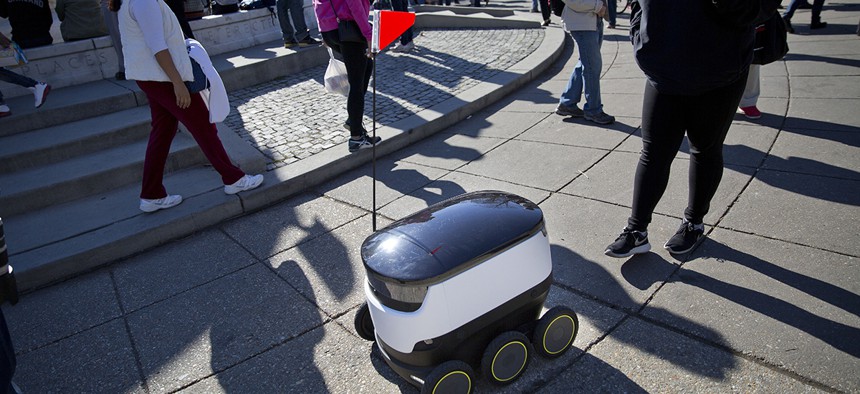San Francisco to Delivery Robots: Get Off the Damn Sidewalk

Pablo Martinez Monsivais/AP
A city lawmaker has proposed legislation banning autonomous delivery-bots. But the battle over who gets to use the sidewalk may just be getting started.
It was only a matter of time until San Francisco again became Ground Zero in a new battle between the public resources of a community and the private reach of technology companies. This week, city supervisor Norman Yee introduced a bill banning delivery robots from San Francisco’s sidewalks and streets.
These delivery robots are what folks strolling around Washington, D.C., have been seeing in recent weeks: six-wheeled boxes, roughly the size of beer coolers, ambling along city sidewalks, delivering food and other items. If passed, Yee’s legislation would halt all deliveries via robot in the city. Violators could face punishment that includes criminal penalties of up to $1,000 in fines or up to six months’ imprisonment.
“Our public spaces should not be commercialized,” Yee said in a statement. “We cannot veer from our vision for San Francisco: to be walkable, accessible and safe, especially for seniors, people with disabilities and young children.”
In Virginia, Idaho and Washington, D.C., laws have been passed allowing for and governing the use of delivery robots, and several other states are now mulling opening their streets and sidewalks.
In San Francisco, the startup Marble has several delivery robots in operation. In D.C., it’s Estonian company Starship Technologies that’s the proprietor of the 35-pound machines trundling along the sidewalks at roughly 4 miles an hour. They maneuver autonomously, using cameras, sensors and GPS, but always with a human monitor waiting in the wings to take over in case of unfamiliar terrain, angry pedestrian attack, or some other problem. (Starship also helped author the laws in Virginia and Idaho, effectively locking out competition from companies that make heavier delivery bots.)
The potential pedestrian hazard of having ottomon-level robots sharing the sidewalks with humans seems to be the central concern of Yee’s bill. What if grandma gets run over by a rogue wheely-bot?
“[The robots] are trained not to inconvenience pedestrians and to operate in a safe and responsible manner,” says Henry Harris-Burland, Starship VP of marketing. “Safety and security is a priority, so they have multiple features to ensure safe operation, including alarms, tracking, cameras and a unique locking mechanism.” The company also points out the service could be a boon for seniors, by delivering food or prescriptions.
But there are two broader questions, tangentially related to safety, worth considering.
The first is traffic, or the mitigation thereof. As CityLab recently wrote, the rise in e-commerce has led to more deliveries crowding city streets, which results in box trucks double-parked or parked where they’re not supposed to be, like in a bike lane. Sidewalk-bound delivery robots could be part of the solution to this digital-age urban dilemma, some experts hope.
“A blanket ban is ludicrous,” says Paul Mackie, communications director for the Virginia-based Mobility Lab. “We are hitting a point where delivery freight vehicles are now taking up so much space. We’re looking at [delivery robots] as a way to reduce traffic.”
For organizations like Walk San Francisco, however, that’s not the point. The real question: How much of the Commons are we willing to cede to tech firms bent on disruption?
“The sidewalks are for walking. That’s why they’re called side walks,” says Cathy DeLuca, interim executive director of Walk SF, which strongly supports Yee’s legislation. “I don’t think it’s asking too much to examine our public spaces and what we want to use them for.”
In other words, don’t alleviate traffic on city streets by creating more congestion on sidewalks. Unfortunately, the deeper issue—insufficient pedestrian real-estate—has already been baked into the system.
“The fundamental problem is too much space for cars and not enough for people,” says David Levinson, University of Sydney School of Civil Engineering professor. “If sidewalks were wider, and there were more bike lanes, the problems with low-speed robots interacting with people could be avoided most of the time.”
In an era of convenience on-demand, we may have to choose exactly how, and where, we’re willing to be inconvenienced. So far, many cities have managed to fend off the advances of Segways, hoverboards and other conveyances that usurp sidewalk space. This latest legal standoff could be decided next month, when Yee’s bill heads to committee.





